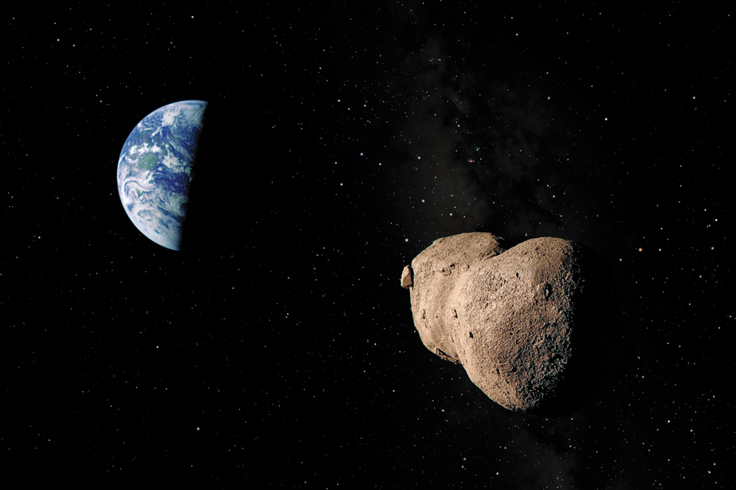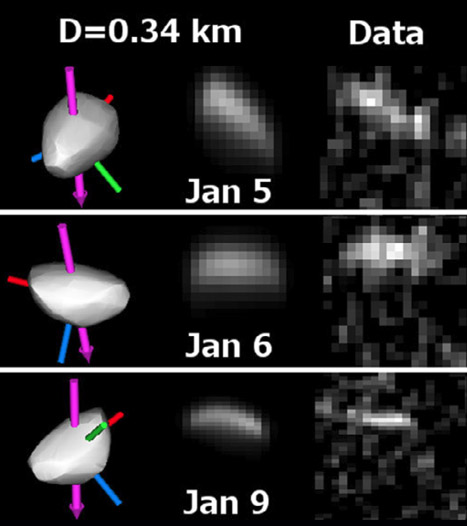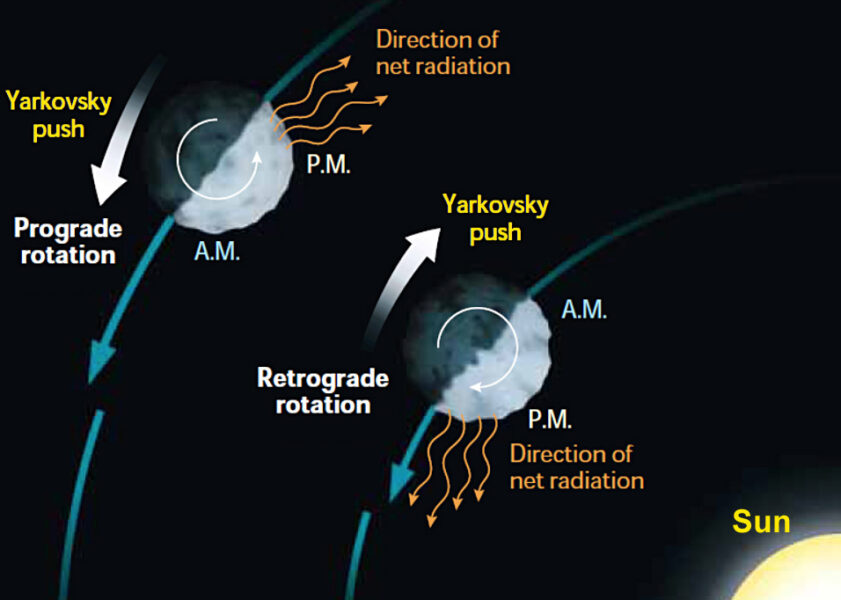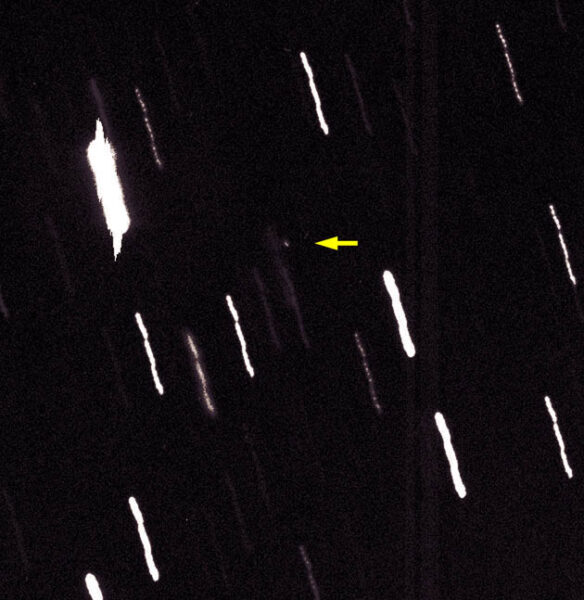When a potentially hazardous asteroid glides safely past Earth on March 6th, astronomers will conduct a dress rehearsal for a dramatic close-miss pass in 2029.
Astronomers have been playing cat-and-mouse with the asteroid 99942 Apophis for nearly two decades.
Six months after its discovery in June 2004, dynamicists calculated that it had a scary 1-in-20 chance of striking Earth in 2029. Then, thanks to more observations, they realized it would sail by safely on that pass but threaten our planet in 2036 instead. Now there’s no danger of a collision in 2036 — radar range measurements ruled that out several years ago — but an ever-so-slight chance of impact remains possible in 2068.
(Perhaps fittingly, Apophis is the Greek name for the Egyptian deity Apep, the demonic serpent-shaped god of evil, chaos, and destruction.)

Dan Durda / 3dimpact.com
All this number-crunching is of much more than academic interest. With a diameter of roughly 350 meters (not quite ¼ mile), Apophis would cause devastating destruction to whatever region on Earth it might hit. So it is in our planet’s best interest to know exactly where this big, dangerous rock will be for the foreseeable future.
That’s why so many astronomers are turning their attention and instrumentation to Apophis this week. It is passing by at the very safe distance of about 16.9 million km (10.5 million miles) on March 6th at 1:15 Universal Time. And although it’ll be closest during evening hours for eastern North America, Apophis will be only 16th magnitude at best and thus a challenging telescopic target.
Still, the ongoing flyby is the final “dress rehearsal” before this potentially hazardous asteroid skims some 31,500 km (19,500 miles) from Earth’s surface on April 13, 2029. So observers are looking to firm up what’s known about Apophis before the “big show” 8 years from now.
What is Apophis Really Like?
For example, radar maps obtained during a somewhat-closer visit in late 2012 reveal that Apophis has an irregular, somewhat elongated shape — with hints that it might have two connected lobes. Meanwhile, telescopic measurements of its light curve showed that the asteroid is probably tumbling slowly, rotating every 263 ± 6 hours but precessing around its spin axis every 30.6 hours.

Marina Brozović & others / Icarus
Observers hope to improve their knowledge of the body’s spin state in the coming days, but the loss of Arecibo Observatory and its unmatched radar capability will hamper that effort. According to a team of radar specialists led by Marina Brozović (Jet Propulsion Laboratory), Arecibo’s radar maps would likely have resolved surface details on Apophis as small 15 m (50 feet).
Instead, radar studies will now rely on the big 70-m (230-foot) dish at NASA’s Goldstone Deep Space Communications Complex in California, working in combination with the 100-m Green Bank Telescope in West Virginia. The hope, notes Lance Benner (JPL), is to refine the asteroid’s orbit and maybe to obtain coarse images to improve knowledge of the spin state and shape.
It would be a big plus to nail down the asteroid’s size and shape, which in turn would improve estimates of its mass. NASA’s NEOWISE spacecraft will sweep over Apophis and measure its brightness at the infrared wavelength of 4.6 microns and perhaps 3.4 microns. Those measurements, combined with visible-light photometry from ground-based telescopes, should lead to a more accurate diameter.
Even better, notes deputy principal investigator Joe Masiero (Caltech), NEOWISE might yield a measurement of the asteroid’s thermal inertia, key to understanding the nature of its surface. Right now, observers only know Apophis to be a uniform gray overall. But is it rocky or deeply dusty? Do lighter and darker patches cover its surface?
Getting a better baseline of these characteristics now will be crucial to observations planned for 2029. During that super-close pass, dynamicists expect that the gravitational pull of Earth will bend Apophis’s trajectory by 28° and yank it onto a new orbit. And there’s also a good chance that terrestrial tides will alter the asteroid’s spin significantly and maybe causes some shifting of its surface material — important clues to the state of its interior.
Tracking the Yarkovsky Effect
Dynamicists now realize that the orbits of small rocky bodies can be slowly change just by the power of sunlight. When sunlight is absorbed by a rotating object and then reradiated as heat in some other direction, the result is a gentle but persistent nudging (generally called the Yarkovsky effect) that over many years can alter the object’s orbit appreciably. Predictions of its location in the distant future — especially if it has some chance of striking Earth — can be thrown off by this dynamical wild card.

Sky & Telescope
In principle, a tumbling Apophis should be good news, because the Yarkovsky effect should become randomized and ultimately alter the orbit very little. But extremely precise positional measurements observations made a year ago by David Tholen (University of Hawai’i) and others with the Subaru Telescope show that Apophis is in fact drifting away from a purely gravitational orbit by about 170 meters (560 feet) per year — which, Tholen points out, is “enough to keep the 2068 impact scenario in play.”
So it’s no surprise that Tholen and many other astronomers worldwide held a dedicated 3-day Apophis workshop in December and have mounted an extensive campaign to observe Apophis by any means possible during this month’s fleeting flyby. Even dedicated amateurs are involved, as they try to record the asteroid’s split-second passage in front an 8th-magnitude star in Hydra on the night of March 6–7.
And even if you’re not equipped to track down Apophis as it slips by Earth, you can join the hunt vicariously thanks to Gianluca Masi’s Virtual Telescope, which will track the asteroid in real time beginning at 0:00 UT on March 6th (Friday, March 5th, at 7:00 p.m. EST, 4:00 p.m. PST).

Roy Tucker / David Tholen / Fabrizio Bernardi
Roy A. Tucker (1951–2021)
Finally, word has spread among both professional and amateur astronomers that Roy A. Tucker, who co-discovered Apophis with David Tholen and Fabrizio Bernardi on June 19, 2004, died today at his home in Tucson, Arizona. This trio spotted the asteroid, initially designated 2004 MN4, while chasing down another recently discovered asteroid with the 90-inch (2.3-m) Bok Telescope atop Kitt Peak in Arizona. Tucker was an instrumentation specialist, a lifelong amateur astronomer, and a prolific discoverer of asteroids. The IAU’s Minor Planet Center credits Tucker with more than 700 numbered asteroids found by him between 1996 and 2010, most from his Goodricke-Pigott Observatory in Tucson, along with two comet discoveries.
 1
1
Comments
Alan MacRobert
March 6, 2021 at 7:25 am
Excellent article, Kelly. It reminded me of why Sky & Telescope gained its reputation as, when you see something astronomical in the news, the place to go to find the real story.
You must be logged in to post a comment.
You must be logged in to post a comment.